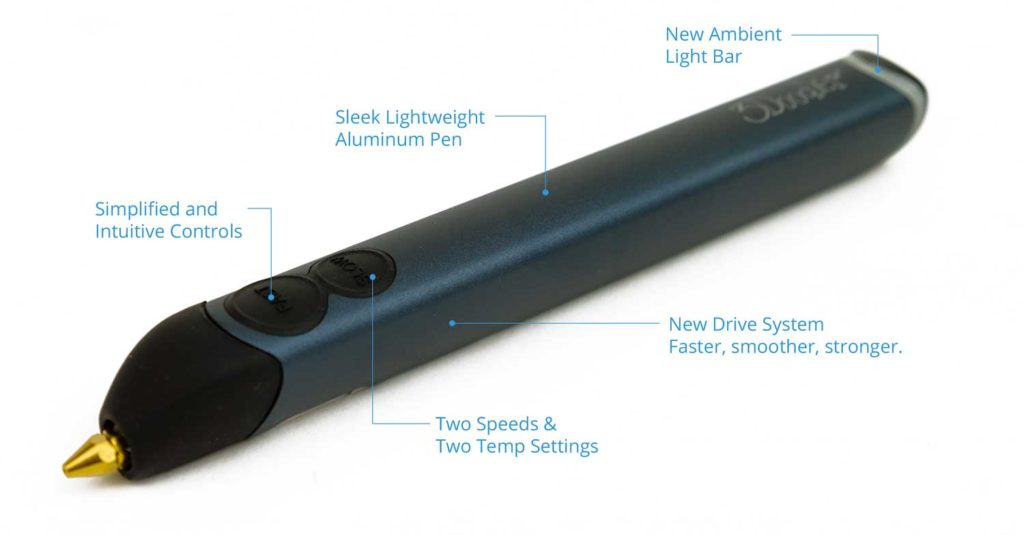Disclosure: This is not a compensated or sponsored post. I was provided the product for review purposes only. All opinions expressed here are my own.
How does a 3D printing pen work?
If you consider a standard 3D printer for a moment, these devices work by applying layers of material (typically plastic) according to a programmed design. The material is built up until a structure is created.
The important distinction between a 3D printer and a 3D printing pen is the design file. With a 3D printing pen, it’s all in the motion of your hands. No programming is required. No 3D design needs to be uploaded to the printer.
The result is a completely user-controlled artistic experience: a 3D printer in your hand!
What’s in the Box?
Under the inspiring illustrations on the box sits the 3Doodler Create 3D printing pen and mains adapter. Alongside you’ll find a collection of maintenance tools (see below), instructions, and a collection of plastic strands of filament. It’s a simple collection, one that lets you get started with it very quickly indeed.
Note that the 3Doodler Create is one of three pens in the range. Also available is the 3Doodler Start for children of ages 8+ and the 3Doodler Pro for, well, professionals.
3Doodler Accessories
While the standard pack is enough to get you started, you might feel like expanding your interest in 3D art. Along with the standard colors included in the 3Doodler Create pack, you can select from a massive palette of 65 in total. These include matte, glossy, and even glow-in-the-dark and sparkle finishes. These start at $4.99 for a pack of 25, but packs of 100 can also be bought for around $15, depending on the color and finish.
You can even alter the size and shape of the 3D printing thanks to a useful Nozzle Set, while the JetPack is a battery pack that lets you take the 3Doodler pen anywhere. There’s even a pedal that lets you control the pen with your feet, rather than press the buttons on the side!
How to Use the 3Doodler Create
Actually getting to grips with the pen itself is remarkably simple.
After powering up and setting the control switch to HI, you can spend a few moments choosing which colored strand to use while the device heats up. An LED will glow red while heating, then blue when ready. At this point, you’re ready to load the plastic.
With the light on blue, feed the plastic into the loading port, which you’ll find below the power connector. You should then press the Fast button once, and wait as the drive gear starts. The next step is to twist the plastic strand clockwise, while pushing it into the port, until it catches the drive gear and is pulled in.
Within 15 seconds, plastic will be pushed out of the nozzle, so press Fast again to stop this.
This simple process is used whenever loading up the 3Doodler Create’s plastic strands. With the plastic ready to use, you can use the Fast and Slow buttons on the side of the pen to extrude the plastic, based on how fast you want to draw with it. This makes it a pretty flexible tool, ideal for constructions and designs of all types.
Get Started: Create!
To start drawing with the 3Doodler Create, use the Fast or Slow buttons on the side of the pen to push the plastic out. You can draw on any surface, but due to the heat, paper is best. Once dry, the plastic can be removed by bending the paper or card. Note that some fabrics can be used, and the plastic will react in different ways (as will the fabric). There’s plenty of scope here for interesting results!
How quickly you move your hand will impact on how the plastic appears. For instance, fast plastic with a slow hand will result in a thick line. Conversely, slow plastic with a fast hand will give thinner plastic.
These different techniques can be used to good effect.
Perhaps the most interesting thing about the 3Doodler pens is the ability to “draw in the air”. Rather than simple extrude plastic onto paper, the 3Doodler Create allows you to take the pen away from the surface, and draw. While you’ll be limited to straight lines — a quick upward motion, followed by a couple of seconds’ stationary is required for this to work — it means you can, for example, make a 3D cube.
Templates are available online and in the instruction manual to help you get started. It’s there you will find the guidelines for building an Eiffel Tower, for instance. But really the way to get good results from this 3D printer pen is to consider the way in which a 3D printer works, and maneuver your hand in the same way.

Leave a Reply